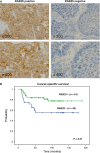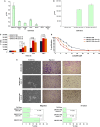High RAB25 expression is associated with good clinical outcome in patients with locally advanced head and neck squamous cell carcinoma
- PMID: 24403269
- PMCID: PMC3892400
- DOI: 10.1002/cam4.153
High RAB25 expression is associated with good clinical outcome in patients with locally advanced head and neck squamous cell carcinoma
Abstract
Currently there are no molecular markers able to predict clinical outcome in locally advanced head and neck squamous cell carcinoma (HNSCC). In a previous microarray study, RAB25 was identified as a potential prognostic marker. The aim of this study was to analyze the association between RAB25 expression and clinical outcome in patients with locally advanced HNSCC treated with standard therapy. In a retrospective immunohistochemical study (n = 97), we observed that RAB25-negative tumors had lower survival (log-rank, P = 0.01) than patients bearing positive tumors. In an independent prospective mRNA study (n = 117), low RAB25 mRNA expression was associated with poor prognosis. Using classification and regression tree analysis (CART) we established two groups of patients according to their RAB25 mRNA level and their risk of death. Low mRNA level was associated with poor local recurrence-free (log-rank, P = 0.005), progression-free (log-rank, P = 0.002) and cancer-specific (log-rank, P < 0.001) survival. Multivariate Cox model analysis showed that low expression of RAB25 was an independent poor prognostic factor for survival (hazard ratio: 3.84, 95% confidence interval: 1.93-7.62, P < 0.001). Patients whose tumors showed high RAB25 expression had a low probability of death after treatment. We also found lower RAB25 expression in tumors than in normal tissue (Mann-Whitney U, P < 0.001). Moreover, overexpression of RAB25 in the UM-SCC-74B HNSCC cell line increased cisplatin sensitivity, and reduced cell migration and invasion. Our findings support a tumor suppressor role for RAB25 in HNSCC and its potential use to identify locally advanced patients with a high probability of survival after genotoxic treatment.
Keywords: HNSCC; RAB25; prognosis; tumor suppressor.
© 2013 The Authors. Cancer Medicine published by John Wiley & Sons Ltd.
Figures




Similar articles
-
Enhanced cell migration and apoptosis resistance may underlie the association between high SERPINE1 expression and poor outcome in head and neck carcinoma patients.Oncotarget. 2015 Oct 6;6(30):29016-33. doi: 10.18632/oncotarget.5032. Oncotarget. 2015. PMID: 26359694 Free PMC article.
-
Rab25 regulates invasion and metastasis in head and neck cancer.Clin Cancer Res. 2013 Mar 15;19(6):1375-88. doi: 10.1158/1078-0432.CCR-12-2858. Epub 2013 Jan 22. Clin Cancer Res. 2013. PMID: 23340300 Free PMC article.
-
Expression of Ras-related protein 25 predicts chemotherapy resistance and prognosis in advanced non-small cell lung cancer.Genet Mol Res. 2015 Oct 30;14(4):13998-4008. doi: 10.4238/2015.October.29.19. Genet Mol Res. 2015. PMID: 26535714
-
[Research progress on the role and mechanism of IGF2BPs family in head and neck squamous carcinoma].Lin Chuang Er Bi Yan Hou Tou Jing Wai Ke Za Zhi. 2024 Dec;38(12):1195-1202. doi: 10.13201/j.issn.2096-7993.2024.12.021. Lin Chuang Er Bi Yan Hou Tou Jing Wai Ke Za Zhi. 2024. PMID: 39605275 Free PMC article. Review. Chinese.
-
Definition of locally recurrent head and neck squamous cell carcinoma: a systematic review and proposal for the Odense-Birmingham definition.Eur Arch Otorhinolaryngol. 2020 Jun;277(6):1593-1599. doi: 10.1007/s00405-020-05953-5. Epub 2020 Apr 7. Eur Arch Otorhinolaryngol. 2020. PMID: 32266461
Cited by
-
High Rab25 expression associates with Ki67/TP53/CD133/VEGFR expression predicts poor prognosis in gastric cancer.Int J Clin Exp Pathol. 2017 Jul 1;10(7):7792-7800. eCollection 2017. Int J Clin Exp Pathol. 2017. PMID: 31966627 Free PMC article.
-
Molecular Subtypes of Oral Squamous Cell Carcinoma Based on Immunosuppression Genes Using a Deep Learning Approach.Front Cell Dev Biol. 2021 Aug 5;9:687245. doi: 10.3389/fcell.2021.687245. eCollection 2021. Front Cell Dev Biol. 2021. PMID: 34422810 Free PMC article.
-
Rab25 acts as an oncogene in luminal B breast cancer and is causally associated with Snail driven EMT.Oncotarget. 2016 Jun 28;7(26):40252-40265. doi: 10.18632/oncotarget.9730. Oncotarget. 2016. PMID: 27259233 Free PMC article.
-
RAB25 expression is epigenetically downregulated in oral and oropharyngeal squamous cell carcinoma with lymph node metastasis.Epigenetics. 2016 Sep;11(9):653-663. doi: 10.1080/15592294.2016.1205176. Epub 2016 Jul 5. Epigenetics. 2016. PMID: 27379752 Free PMC article.
-
Enhanced cell migration and apoptosis resistance may underlie the association between high SERPINE1 expression and poor outcome in head and neck carcinoma patients.Oncotarget. 2015 Oct 6;6(30):29016-33. doi: 10.18632/oncotarget.5032. Oncotarget. 2015. PMID: 26359694 Free PMC article.
References
-
- Jemal A, Bray F, Center MM, Ferlay J, Ward E, Forman D. Global cancer statistics. CA Cancer J. Clin. 2011;61:69–90. - PubMed
-
- Leemans CR, Braakhuis BJ, Brakenhoff RH. The molecular biology of head and neck cancer. Nat. Rev. Cancer. 2011;11:9–22. - PubMed
-
- Pfister DG, Ang KK, Brizel DM, Burtness BA, Cmelak AJ, Colevas AD, et al. Head and neck cancers. J. Natl. Compr. Canc. Netw. 2011;9:596–650. - PubMed
Publication types
MeSH terms
Substances
LinkOut - more resources
Full Text Sources
Other Literature Sources
Medical
Research Materials

